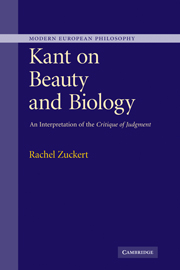Book contents
- Frontmatter
- Contents
- Acknowledgments
- Note on citations
- Introduction
- 1 The problem: The unity of the diverse
- 2 Reflective judgment and its principle: Preliminary remarks
- Part I Teleological judgment
- 3 The analytic of teleological judgment: Purposive unity is the “highest formal unity”
- 4 A merely subjective principle: Time and the “peculiarities” of our intellects
- Part II Aesthetic judgment
- Conclusion
- Bibliography of works cited
- Index
3 - The analytic of teleological judgment: Purposive unity is the “highest formal unity”
from Part I - Teleological judgment
Published online by Cambridge University Press: 22 September 2009
- Frontmatter
- Contents
- Acknowledgments
- Note on citations
- Introduction
- 1 The problem: The unity of the diverse
- 2 Reflective judgment and its principle: Preliminary remarks
- Part I Teleological judgment
- 3 The analytic of teleological judgment: Purposive unity is the “highest formal unity”
- 4 A merely subjective principle: Time and the “peculiarities” of our intellects
- Part II Aesthetic judgment
- Conclusion
- Bibliography of works cited
- Index
Summary
As we have seen, Kant argues in the introductions to the CJ that, in order to make (justifiable) empirical knowledge claims, we require a principle of the unity of the diverse as such, which requirement is in part enunciated as a normative demand that we aim at a unified, systematic science. It seems somewhat odd, then, that Kant devotes the second part of the CJ, the Critique of Teleological Judgment, to defending the autonomy of teleological judgment in biology within natural science, i.e., to an argument that we must judge organisms in a way distinct from physical, mechanical explanation. As I shall discuss in the next chapter, Kant is himself ambivalent concerning this argument, in part for such systematic scientific reasons, and therefore restricts these conclusions: teleological judgment is merely reflective judgment, not explanation properly speaking; we ought to look for mechanical, not teleological, explanations of biological functioning as much as possible (e.g., v:418). In this chapter, however, I shall concentrate on Kant's positive treatment of teleological explanation, his argument that it is necessary to judge organisms teleologically. I shall suggest that Kant's defense of teleological explanation of organisms is not as anti-systematic as it may seem. Kant associates natural teleology with the systematic unity of nature (and science) already in the CPR Appendix to the Dialectic and, though Kant modifies this view in the CTJ, he nonetheless continues to link the two: organisms are, Kant holds, “systematic in form,” unities of the diverse as such, and thus instantiate the type of unity he seeks to ground in judgment, science, or nature.
- Type
- Chapter
- Information
- Kant on Beauty and BiologyAn Interpretation of the 'Critique of Judgment', pp. 89 - 129Publisher: Cambridge University PressPrint publication year: 2007

